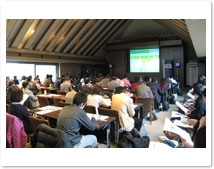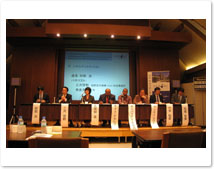<Program>
1. Introduction (13:00)
Osamu Abe (ESDRC):
Opening remarks and explanation on the aim of symposium
Izumi Kubota (National Institute of Environmental Studies): PDF
"The Impacts of Climate Change and Adaptation in the Pacific Island Countries"
Ko Nomura (ESDRC): PDF
"Education and the Development of Adaptive Capacity"
2. Activities in the Pacific (14:00)
Taito Nakalevu (SPREP): PDF
"The Adaptation and Education of Climate Change:SPREP’s practice"
Sanivalati Navuku (WWF Fiji): PDF
"Building Adaptive Ability in Fiji"
Aliti Koroi (PACE-SD/USP): PDF
"Building Adaptive Capacity to Climate Change in the Pacific: Challenges for
Education & International Cooperation"
3. Practices in Japan (15:20)
Kazuhiko Takemoto (The Japanese Ministry of Environment): PDF
"Activities of the Japanese Government: Building Adaptive Capacity in Island
Countries"
Shigeyuki Baba (ISME / Ryukyu University): PDF
"ISME’s Activities and Lessons Learned"
4. Panel Discussion (16:10)
Moderator: Osamu Abe
Panelists: The presenters above and Keito Mitsugi(JICA)
"The Possibility of Education and International Cooperation for Building Adaptive
Capacity"
<Symposium Report>
1.The purpose of the symposium
This symposium was held to discuss and raise awareness of the significance of environmental education and international cooperation (with governments, NGOs, private sectors, and universities), to promote activities for the “adaptive capacity” on the impacts of climate change in the Pacific islands. The guest speakers were the leading researchers and practitioners in this field, from SPREP, WWF Fiji, USP/PACE-SD in the Pacific region, and National Institute of Environmental Studies, the Ministry of Environment, and Ryukyu University in Japan.
2.Opening remarks
Prior to each presentation, the director of ESDRC, Osamu Abe, introduced the activities carried out by the ESDRC Pacific team; the public lecture for global warming with the prime minister of Tuvalu, Apisai Ielemia, held in 2007, a project for accepting students from Tuvalu to Rikkyo Gakuin. This symposium was a series of activities carried out by the ESDRC providing a fruitful opportunity to understand the significance of environmental education for “adaptation” of climate change to enhance the future network and research activities in the Pacific region.
3.Presentations
A summary of each presentation.
 <Dr. Izumi Kubota (National Institute of Environmental Studies)> PDF <Dr. Izumi Kubota (National Institute of Environmental Studies)> PDF
Dr. Izumi Kubota divided the measures to global warming into “mitigation” and “adaptation”. She defined “Adaptation” as adjusting the human and natural system to the impacts of climate change to reduce the damage caused by it. The importance of this has been recently recognized. She mentioned that the adaptation measure is strongly needed for the Pacific region, where various sectors could get severely damaged. She emphasized the importance of a support system; required to facilitate the implementation of these measures on a local basis.
<Ko Nomura (ESDRC)> PDF
The research fellow of ESDRC, Ko Nomura, mentioned that an area with social problems (e.g. poverty) would be more vulnerable to the impacts of climate change and for that reason appropriate measures should be implemented depending on the specific local context. Referring to Kiribati, he laid stress on the significant role of education to encourage actual practices by communities on their own as well as raising awareness of the problems. Furthermore, he suggested that it is also required to develop a system to expand grass-root projects promoting the participation of universities and NGOs that have various educational resources and experience. He pointed out the difficulty of adapting to impacts that have never been experienced.
<Taito Nakalevu (SPREP)> PDF
Mr. Taito Nakalevu mentioned that SPREP stands for the Secretariat of the Pacific Regional Environment Programme, in which 21 pacific islands participate. He introduced CBDAMPIC (the Capacity Building for the Development of Adaptation in PICs) and CV&A (Community Vulnerability & Adaptation Assessment and Action Guideline) as the “bottom-up” projects carried out by SPREP, and emphasized the significance of promoting long term effects on education in communities to build up adaptive ability. He expressed that incorporating environmental education into primary and higher education systems would be critical for future education on environmental issues.
<Sanivalati Navuku (WWF Fiji)> PDF
Mr. Sanivalati Navuku mentioned that WWF Fiji’s vision and mission is to promote and enhance a healthy and sustainable environment through programs that support social and economic well being and extend culturally appropriate methods of nature conservation through effective stakeholder partnerships. He introduced the Climate Winess Programme, a community based project to encourage villagers to keep records of the noticeable changes caused by climate change in their own villages. He also introduced a community based marine resource management project combined with an idea from a Fijian traditional custom. These projects are also designed to raise the awareness of the importance of conservation among people in local communities and encourage them to take action spontaneously.
<Aliti Koroi (USP/PACE-SD)> PDF
Ms. Aliti Koroi stated that USP is jointly owned by 12 PICs, the premier institution for higher learning for the South Pacific region. PACE-SD was introduced in USP Strategic Plan in 1999 at first and later founded as a focal point for Environment and Sustainable Development within USP. It offers various courses from postgraduate teaching to short term training lasting 1-2 weeks on the vulnerability of the Pacific Islands to climate change and strategies to adapt to climate change. PACE-SD also encourages field research to create climate change scenarios to examine sectoral impacts and so on.
< Kazuhiko Takemoto (the Japanese Ministry of Environment)> PDF
Mr. Kazuhiko Takemoto introduced scientific data related to climate change and the international trend of the current discussion for the next framework plan on climate change. One of the 5 components of the Bali Action Plan is to strengthen and promote the action for adaptation at COP13 in Bali, the issues of Adaptation Fund and the distribution of the profit from Clean Development Mechanism were discussed. He also mentioned that through "Cool Earth Partnership", a new financial mechanism, the Japanese government has planned to fund developing countries with a total of 10 billion dollars until 2012. He introduced the partnership plan with the Pacific island countries, the educational aid through ProSPER.Net and other plans for adaptation aid by the Japanese government, and emphasized the importance of the partnership with the government and private sector.
<Shigeyuki Baba (Ryukyu University・ISME)> PDF
Professor Shigeyuki Baba introduced ISME, the international NGO/NPO. ISME investigates and dispatches the information of mangroves around the world. It also engages in mangrove forestation and preservation and training activities through JICA. He mentioned that mangrove plantation could effectively contribute to reduce carbon dioxide with the ability to accumulate more carbon in the soil than the other trees. He also said that mangrove could be an effective educational tool to give children and local residents an opportunity to learn about environmental issues. Towards the end of his presentation, emphasis was put on the significance to broaden and strengthen the network between communities to cooperate with each other and to develop a system to support and encourage the communities to maintain a network and their activities.
 4.Panel Discussion 4.Panel Discussion
After each presentation, a panel discussion was held to discuss the potential of education and international cooperation to build up the adaptive capacity in the Pacific. Mr. Keito Mitsugi from JICA joined the talk and mentioned that the poor are more vulnerable to the negative impacts of climate change and talked about one example; the damage caused by a cyclone in Myanmar was relatively small in an area with mangrove plants. Introducing the coral reef monitoring activity initiated by JICA in Republic of Palau, he also emphasized the significance of broadening the network and strengthening the relationship with the Pacific islands along the existing framework.
Receiving questions from the floor related to disaster measures, Mr. Mitsugi, Mr. Nakalevu, and Mr. Takemoto pointed out the importance of the local base measures, community initiatives, and support for them.
Dr. Kubota said she realized the significance of human resource development for adaptation planning on various levels and the combination with natural and social scientific knowledge to assess the impacts. Mr. Navuku emphasized the value of inter-sectoral activities and hoped to further promote the community-based measures for adaptation in the future. Mr. Nakalevu pointed out the importance of incorporating “education” into adaptation measures and reinforcing the network with USP and NGOs. Ms. Koroi laid stress on the role of ESD in the Pacific region. Mr. Takemoto stated it is required for the Japanese government to enhance their relationship with SPREP and USP etc. Professor Baba expressed his view that the first and most important step is to listen to and understand the voices of the communities and to take action based on guidelines formulated by communities and NGO/NPO, also for policy makers to encourage activities on a local level. The former Japanese minister of environment, Ms Yuriko Koike, provided closing remarks to end the symposium. |